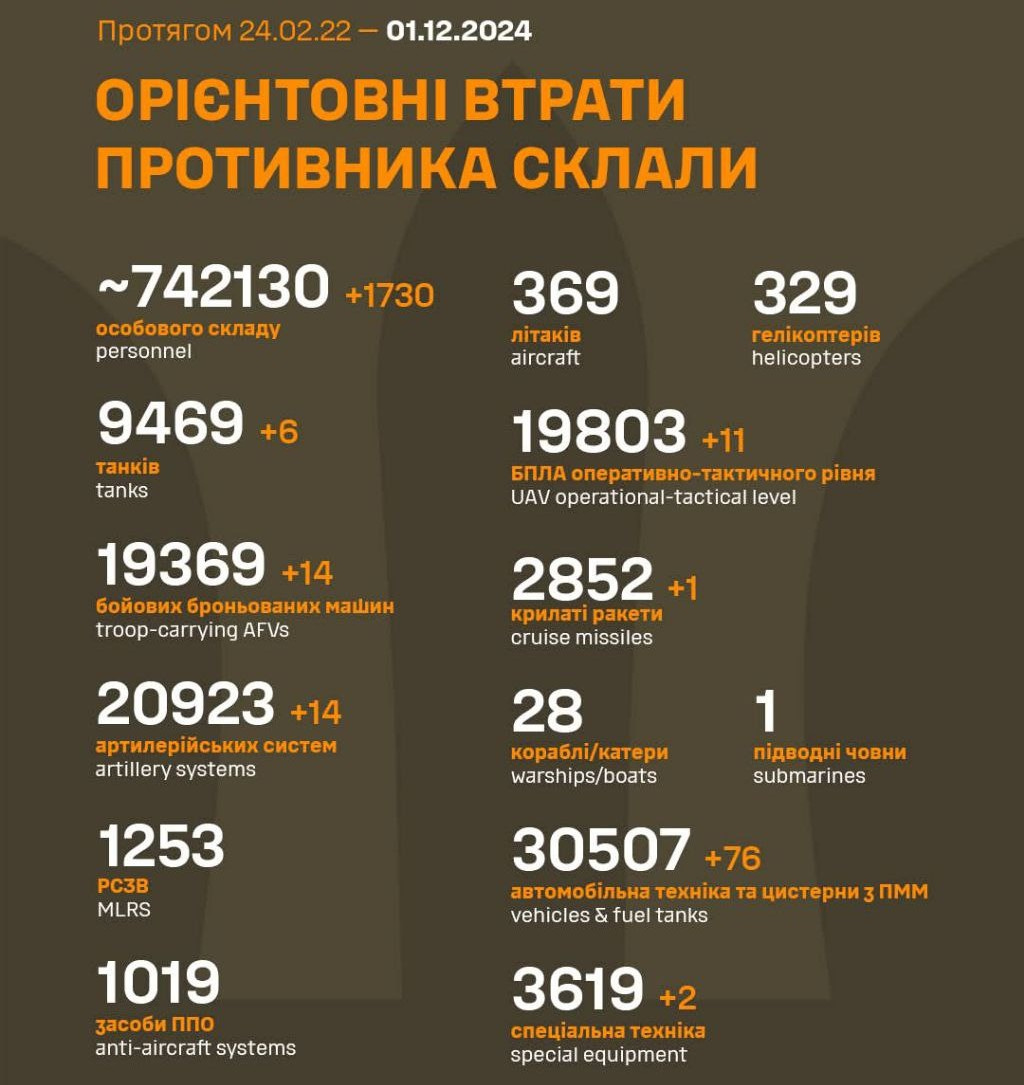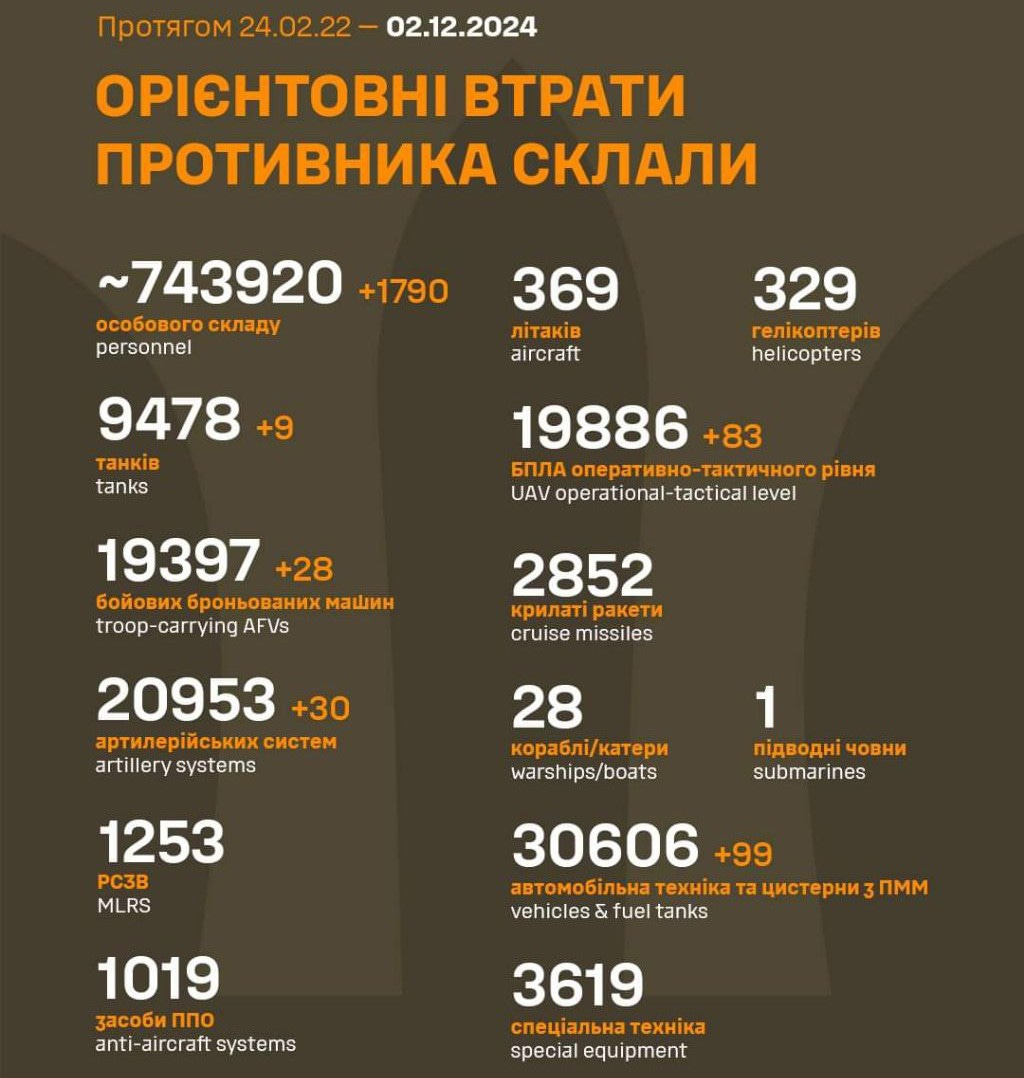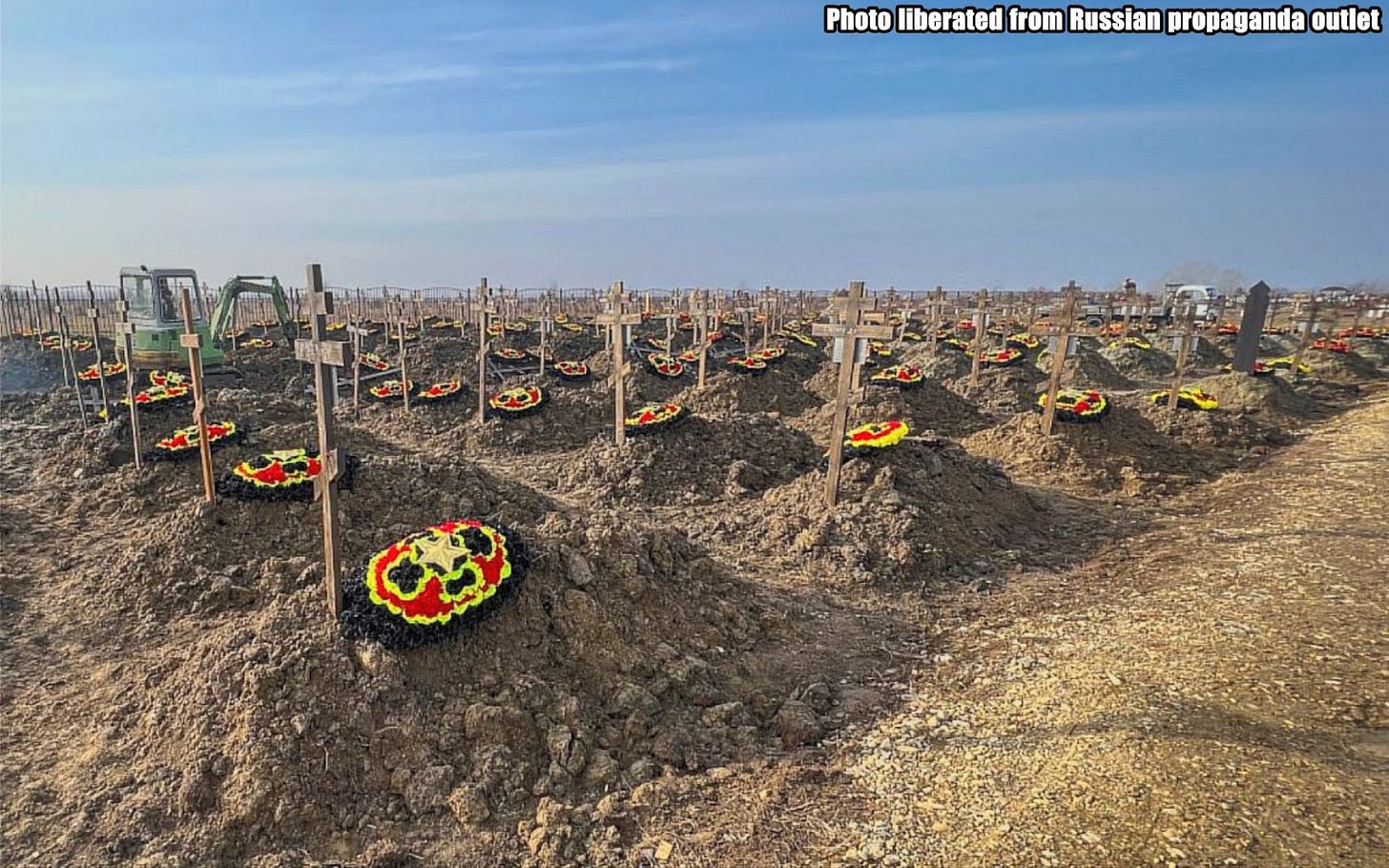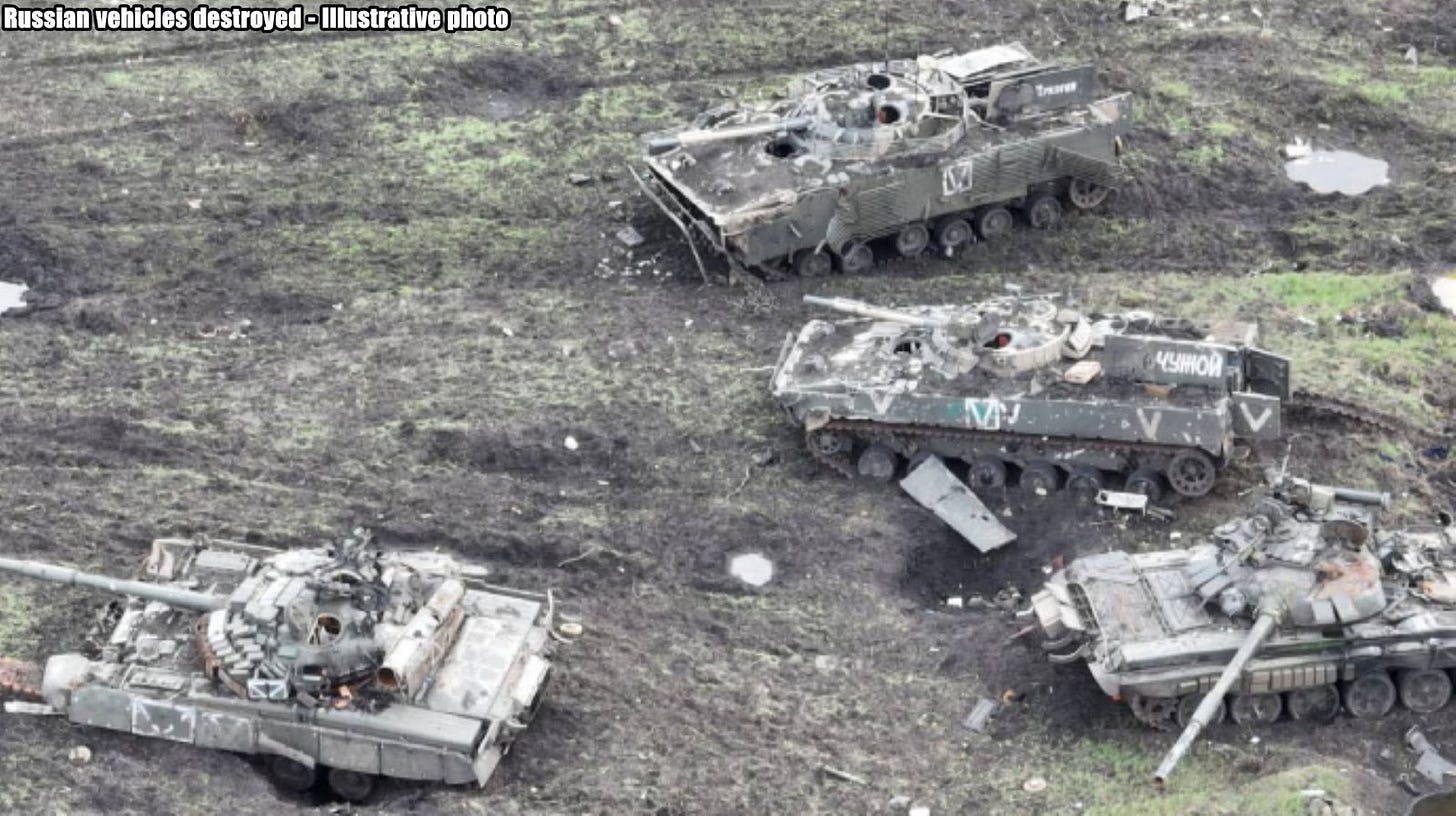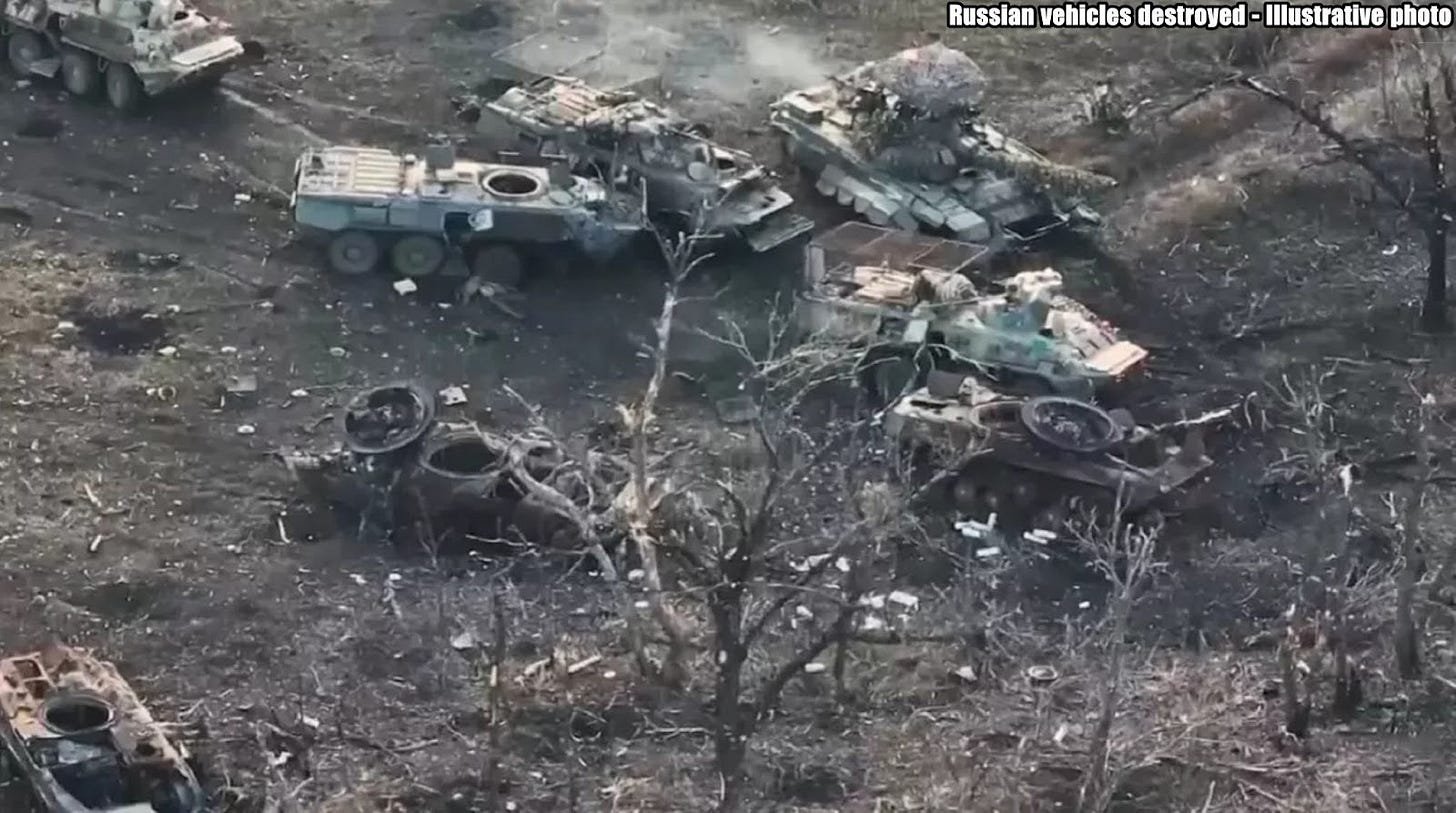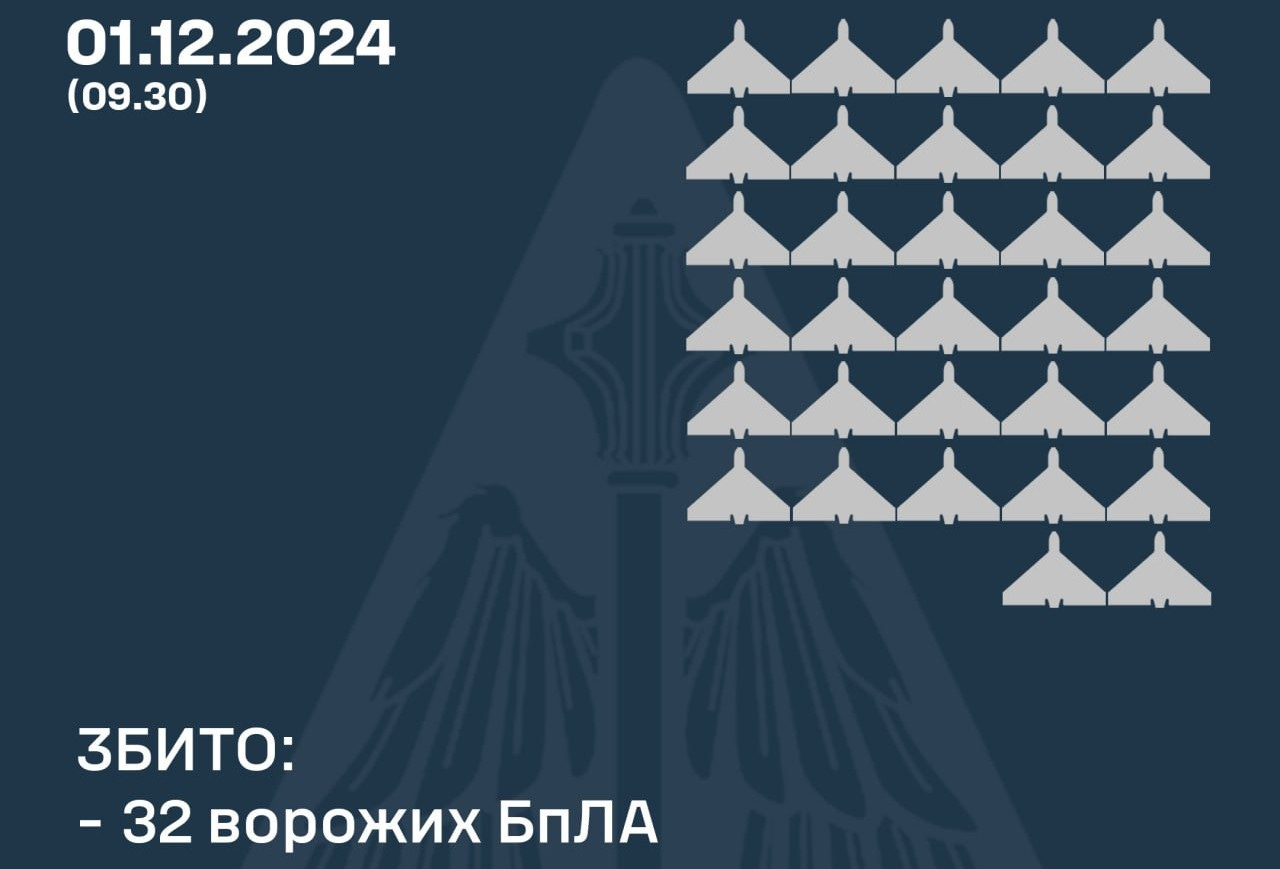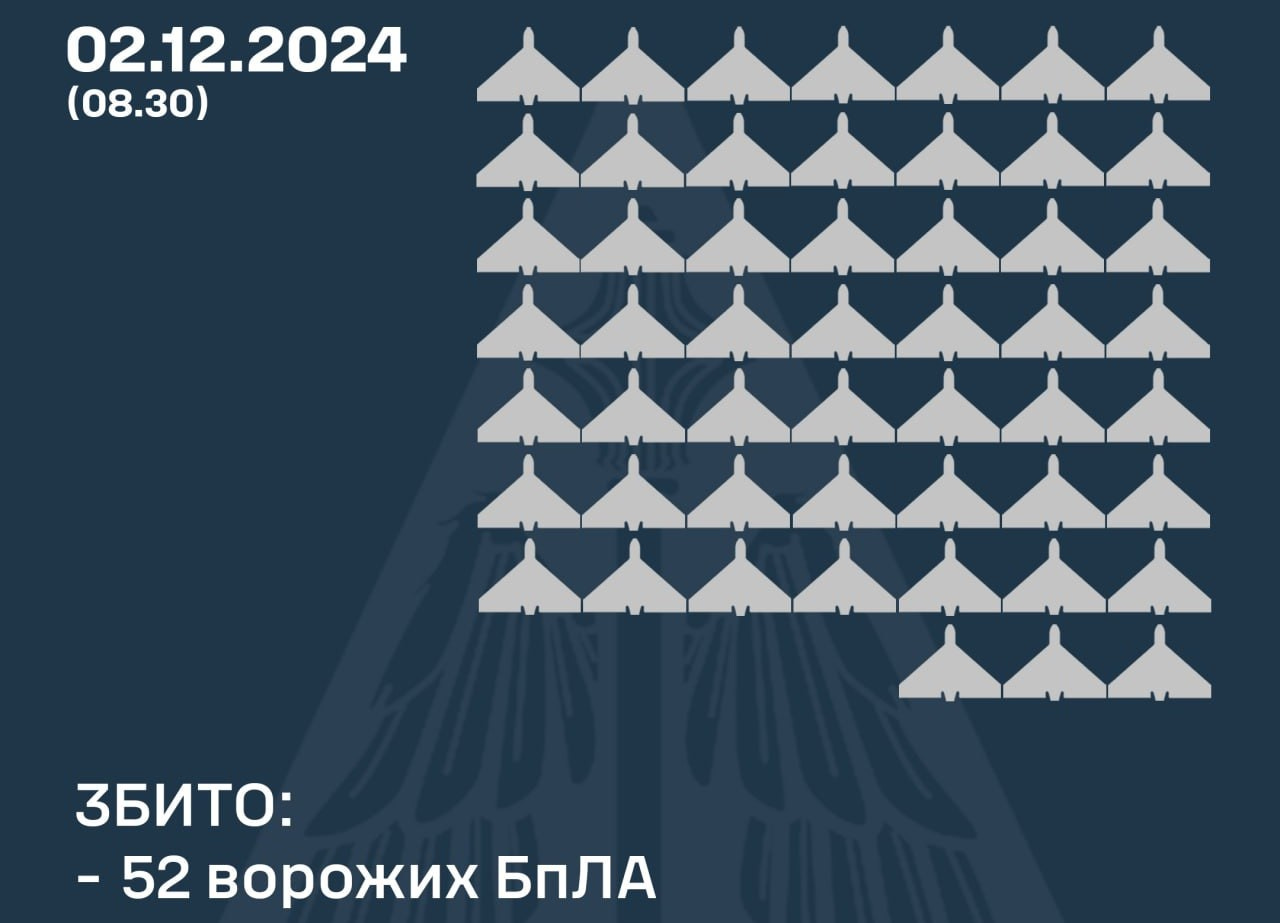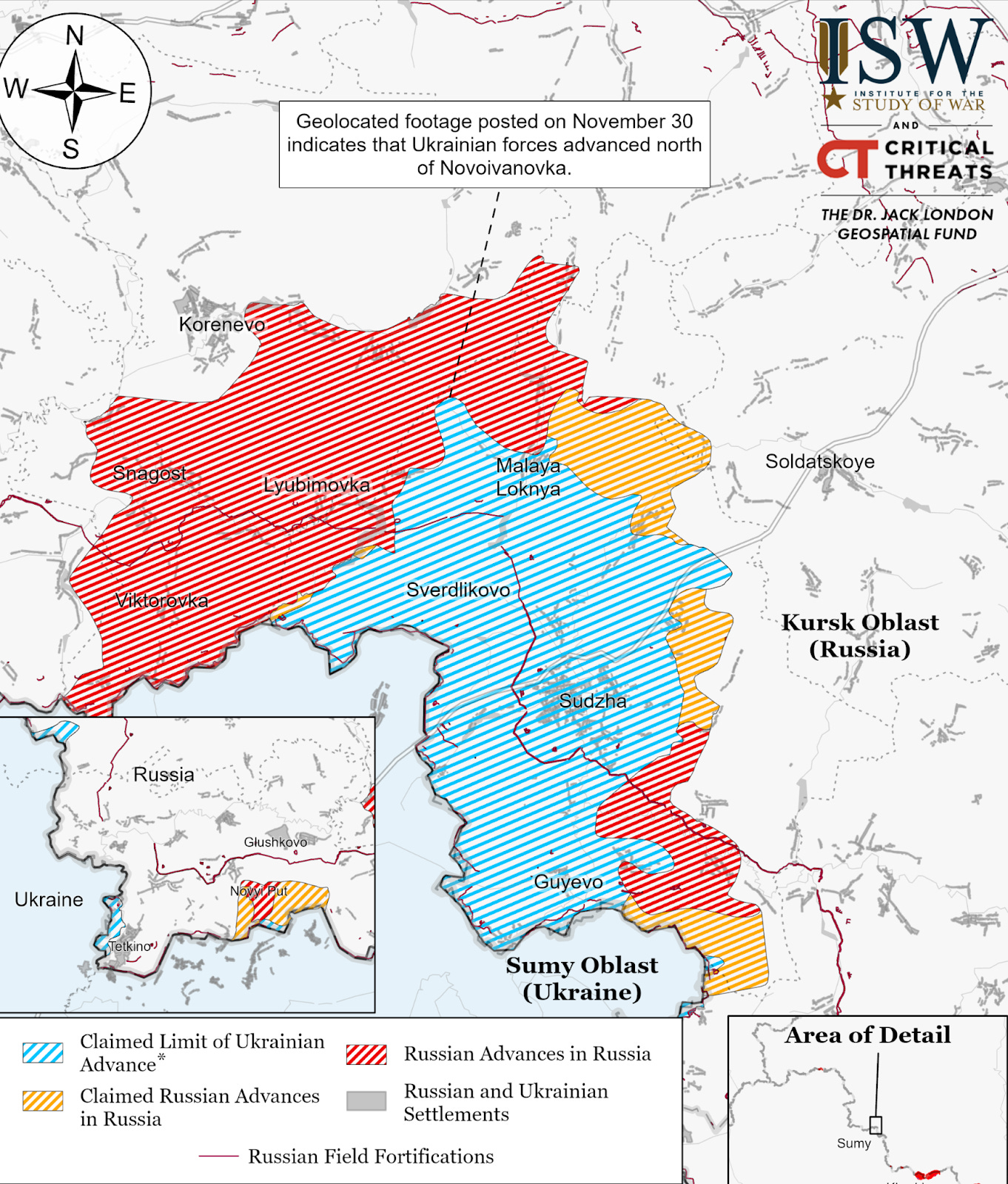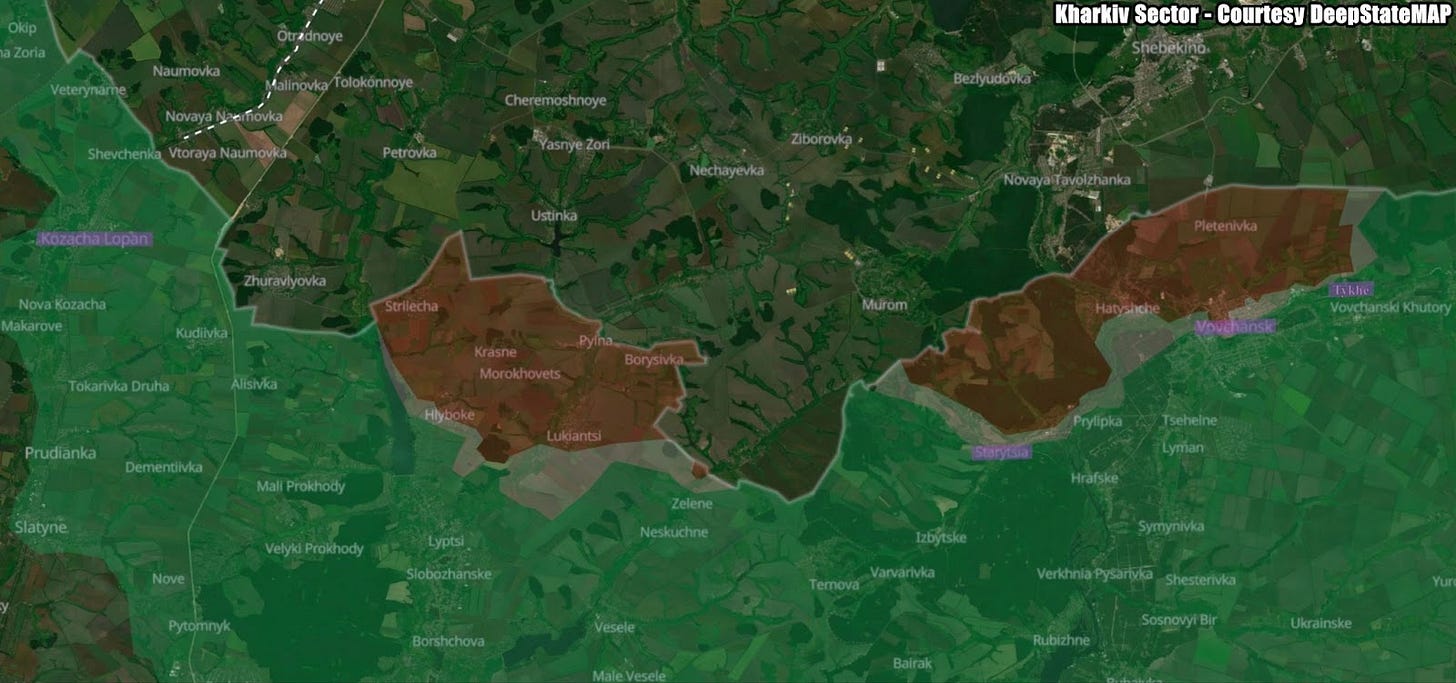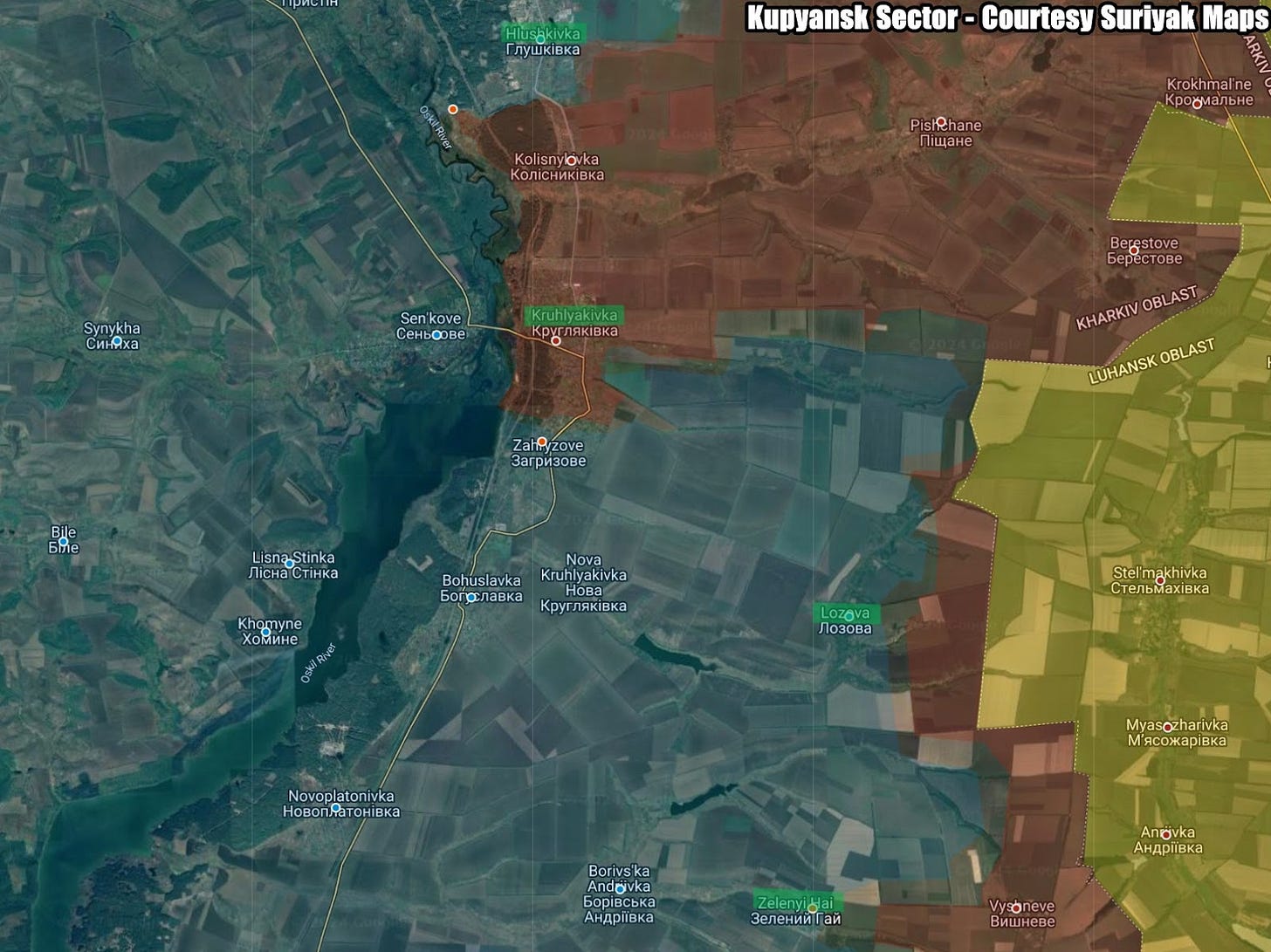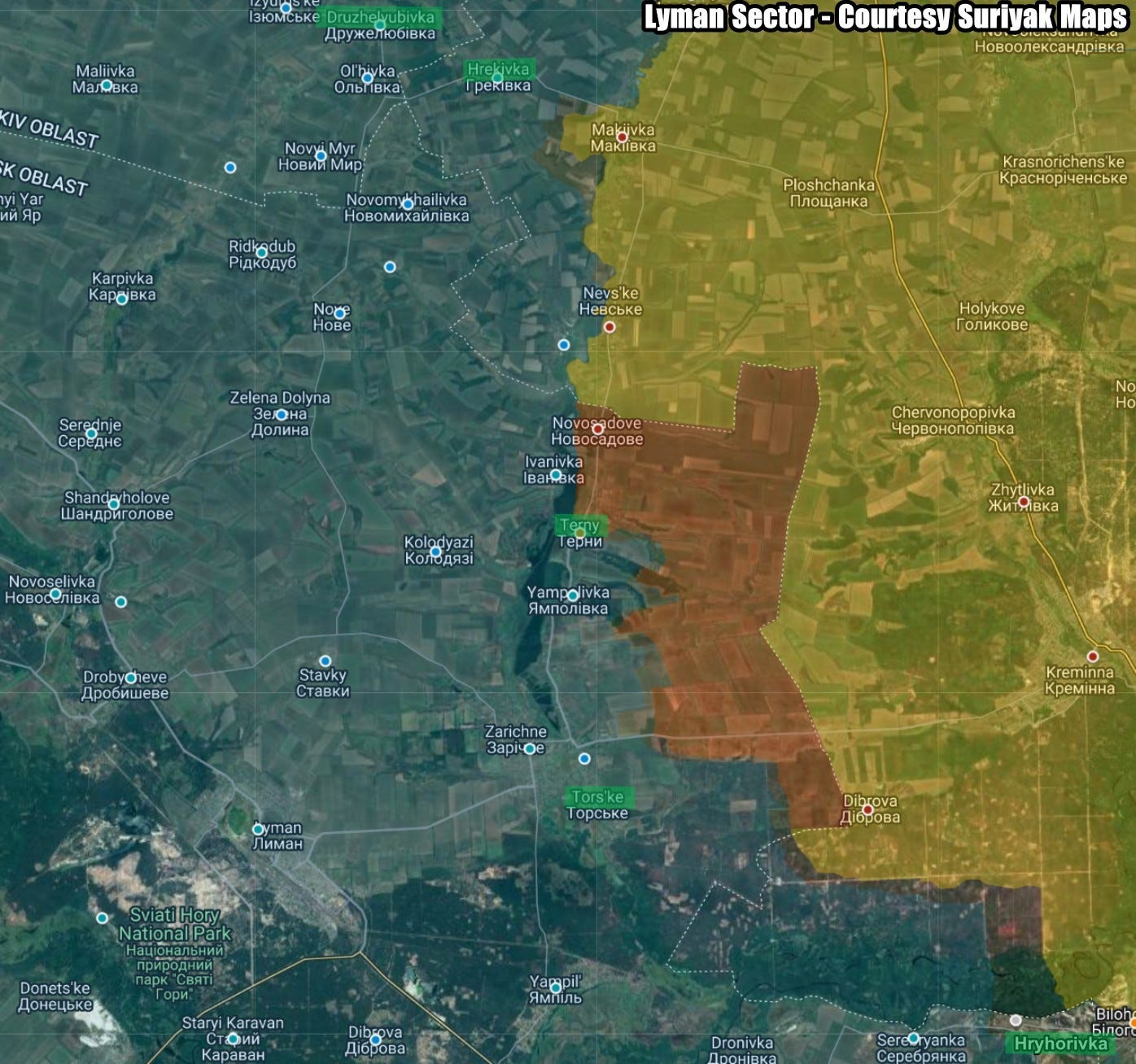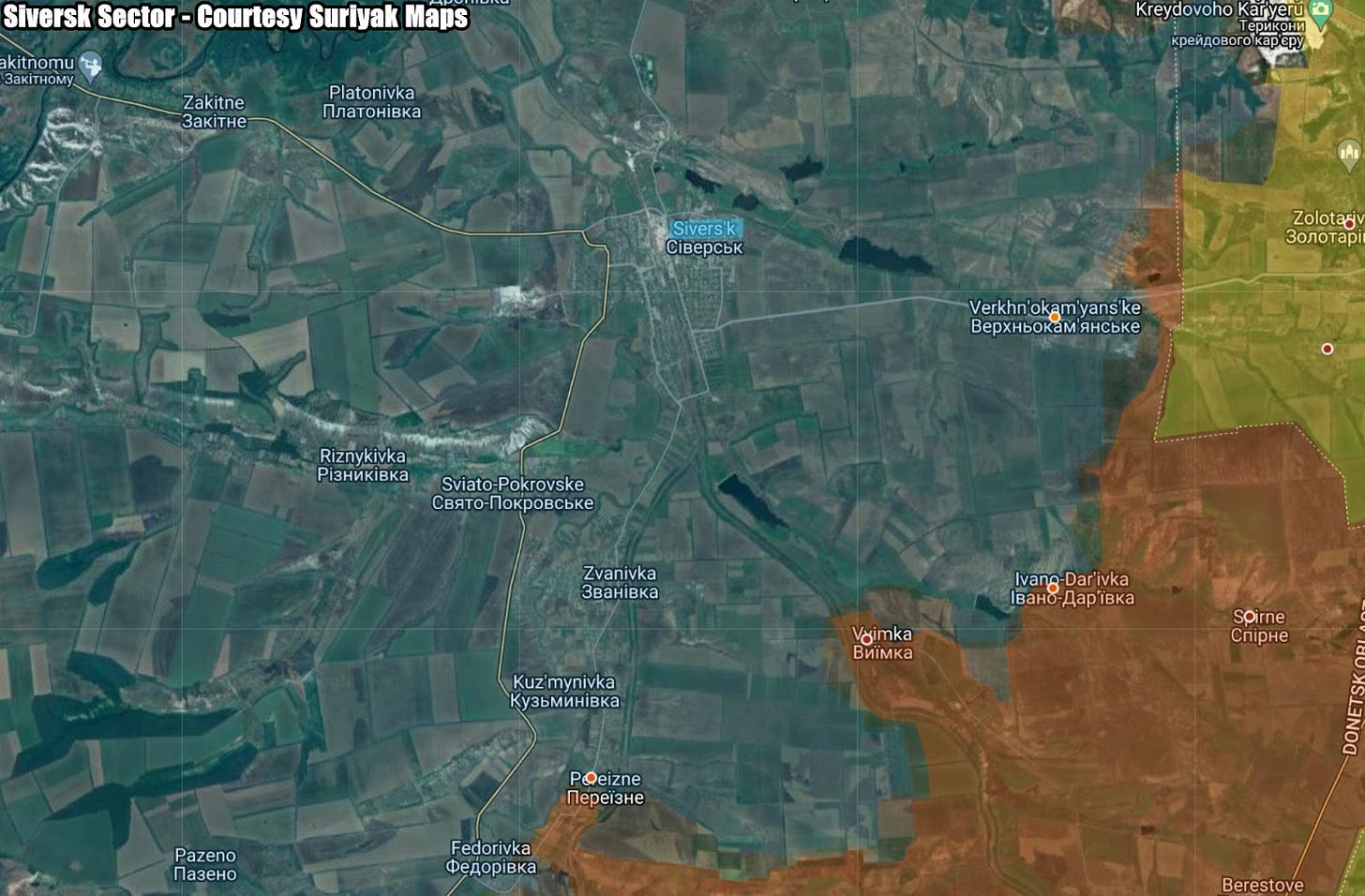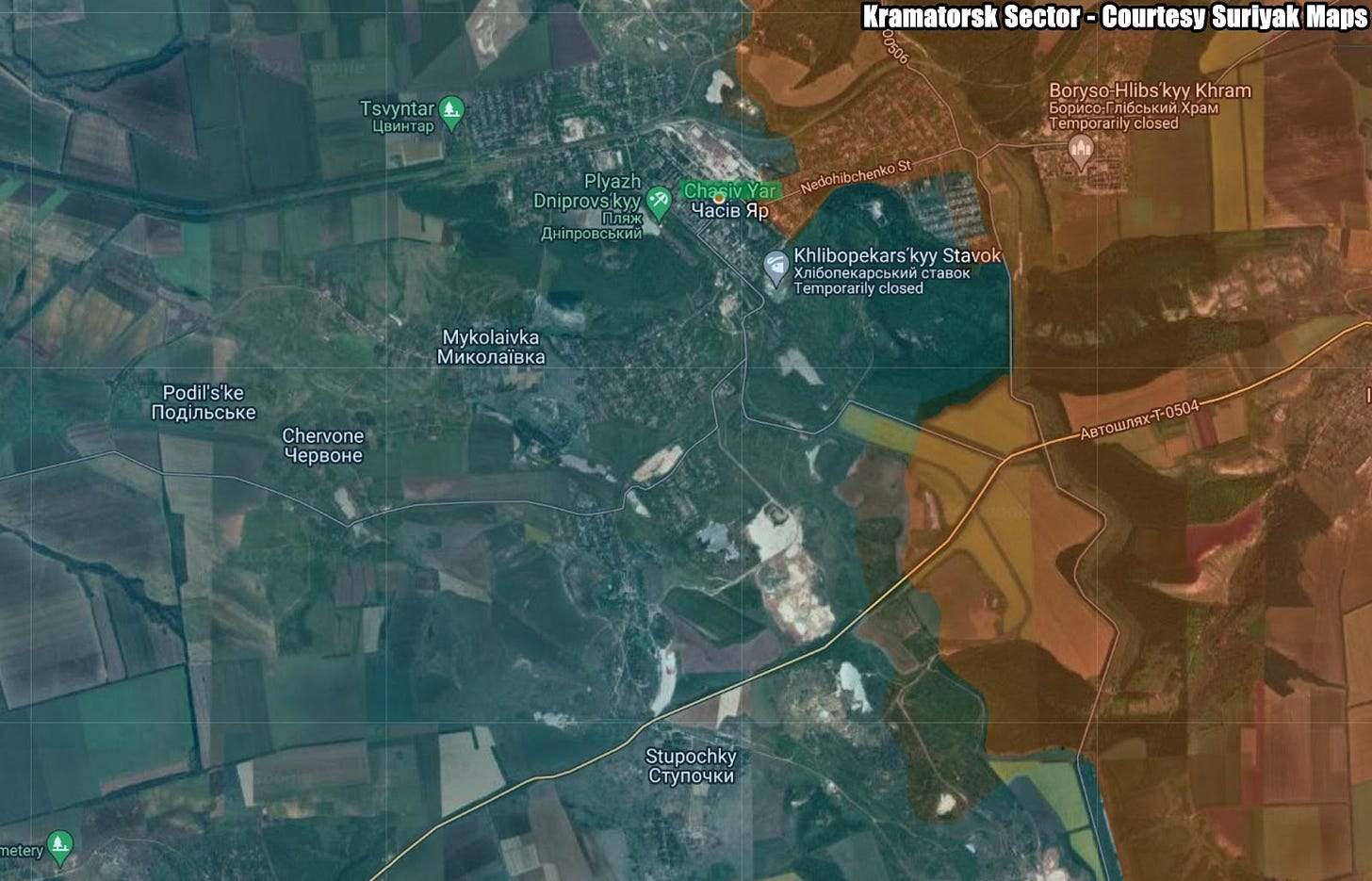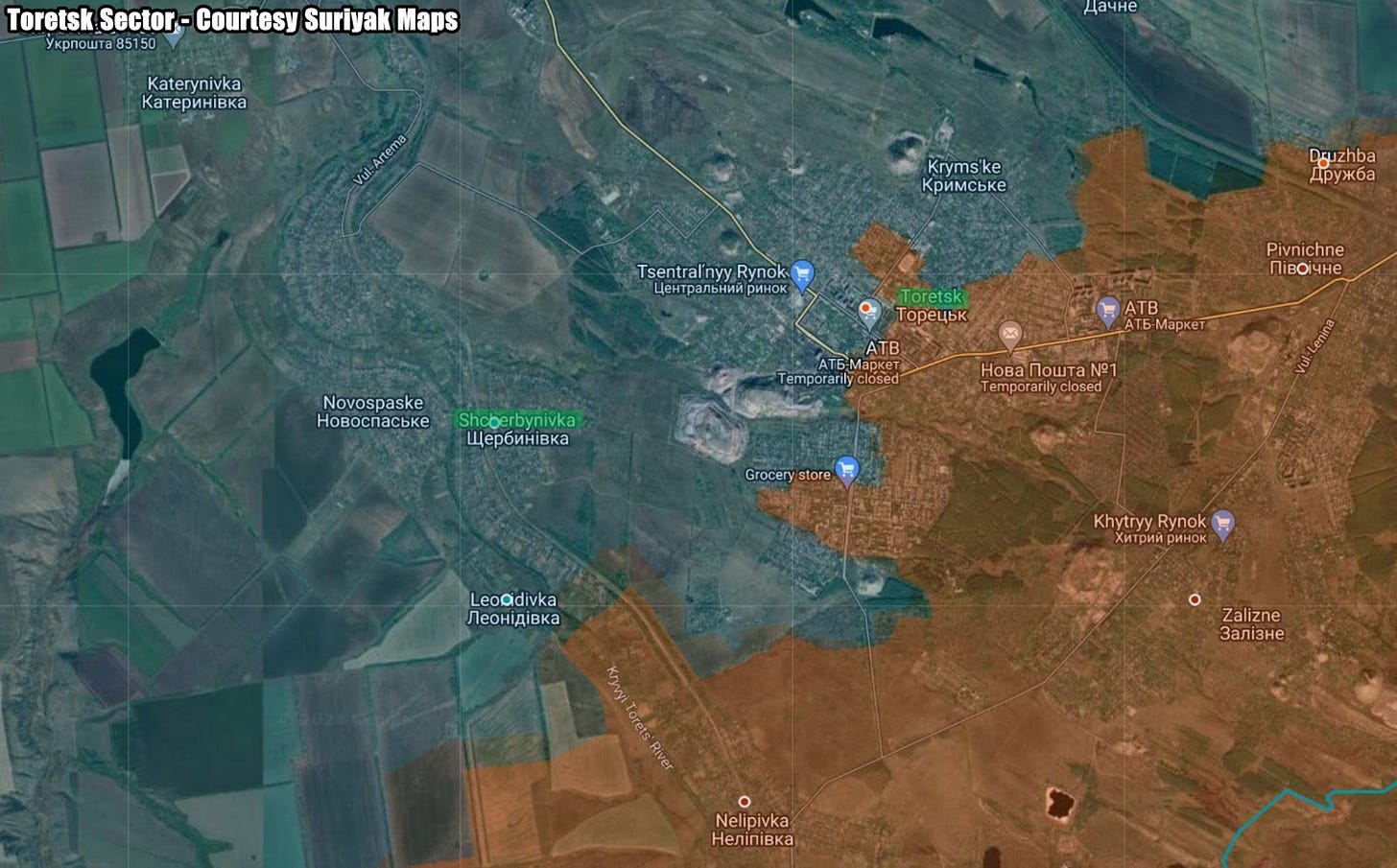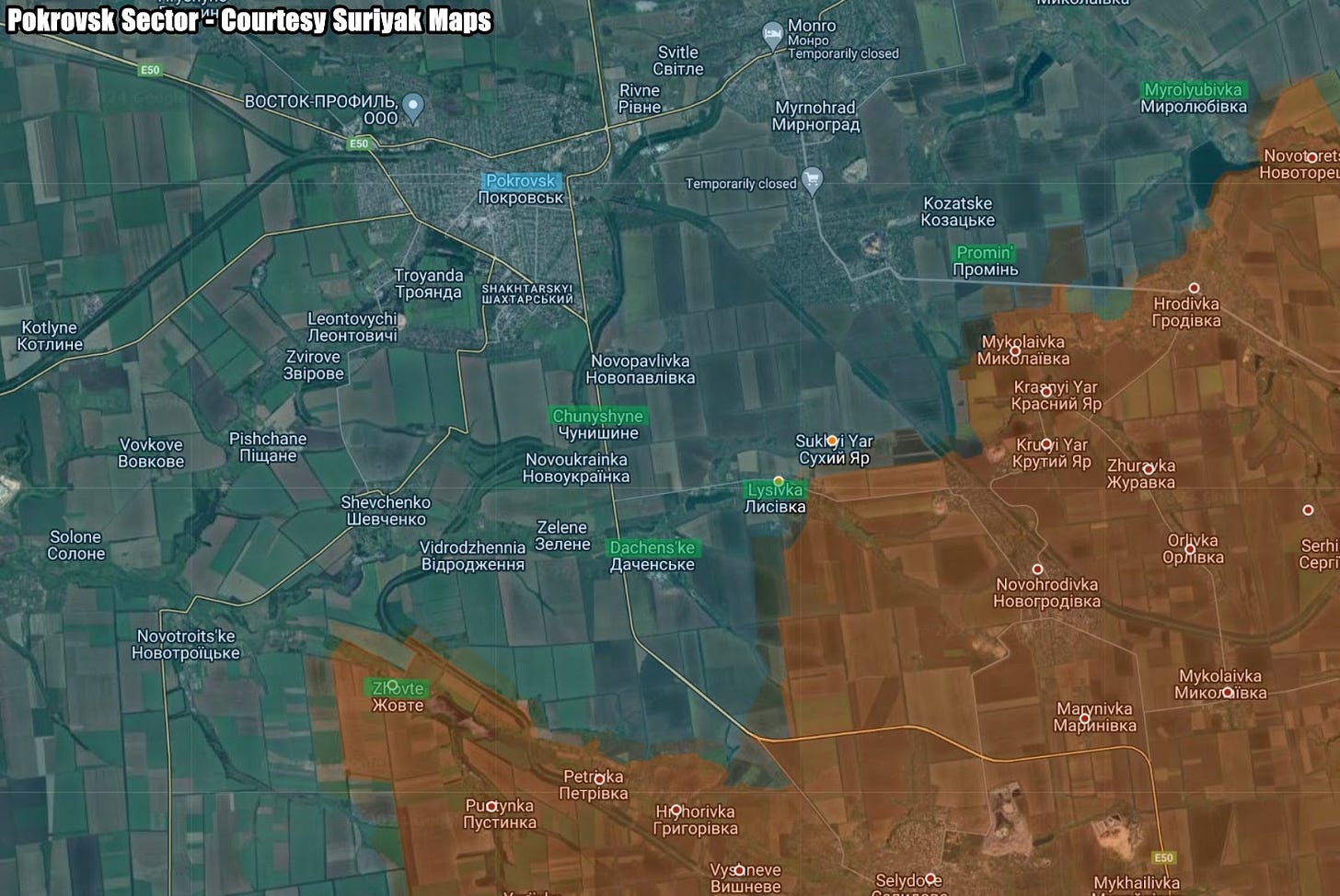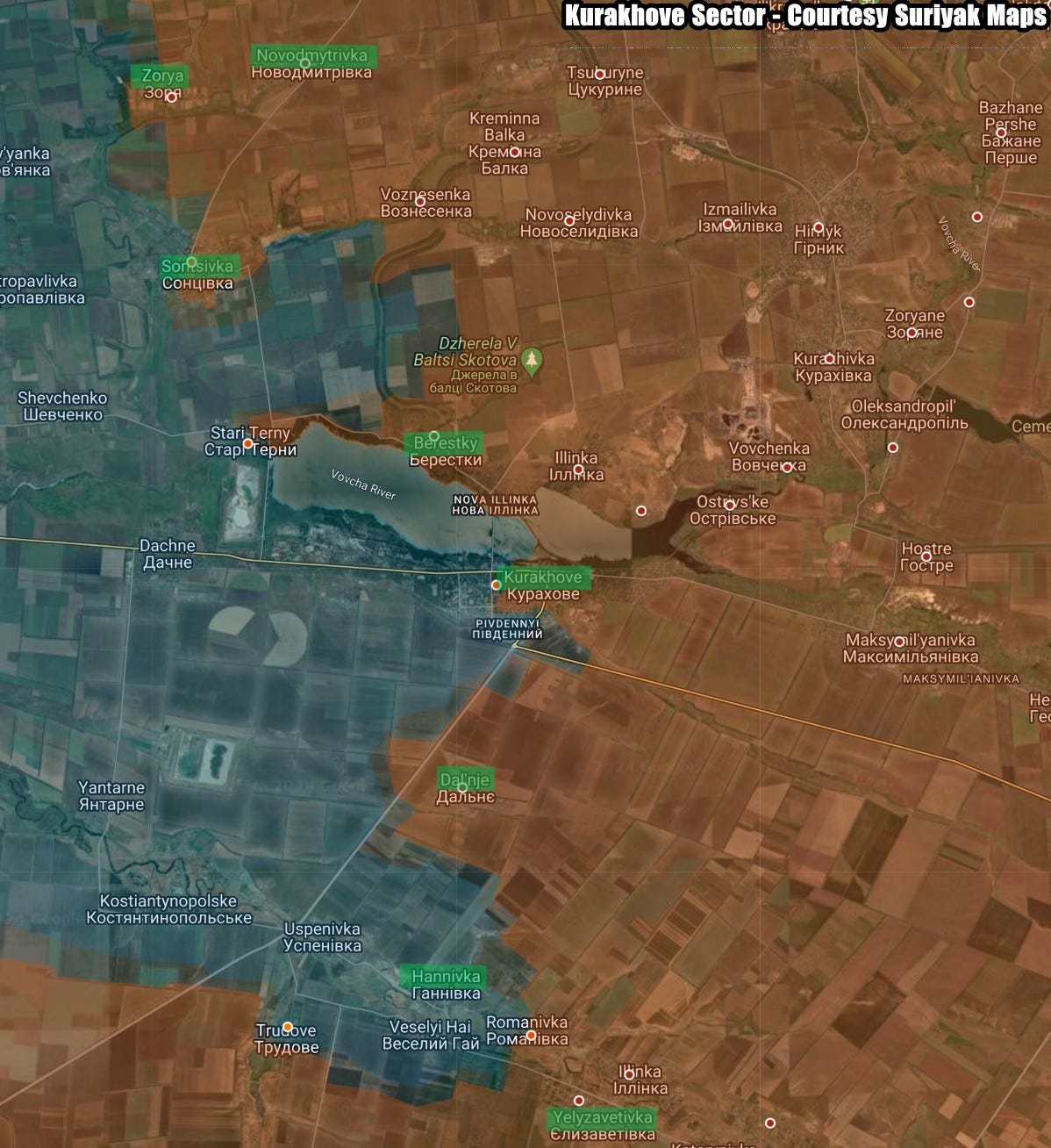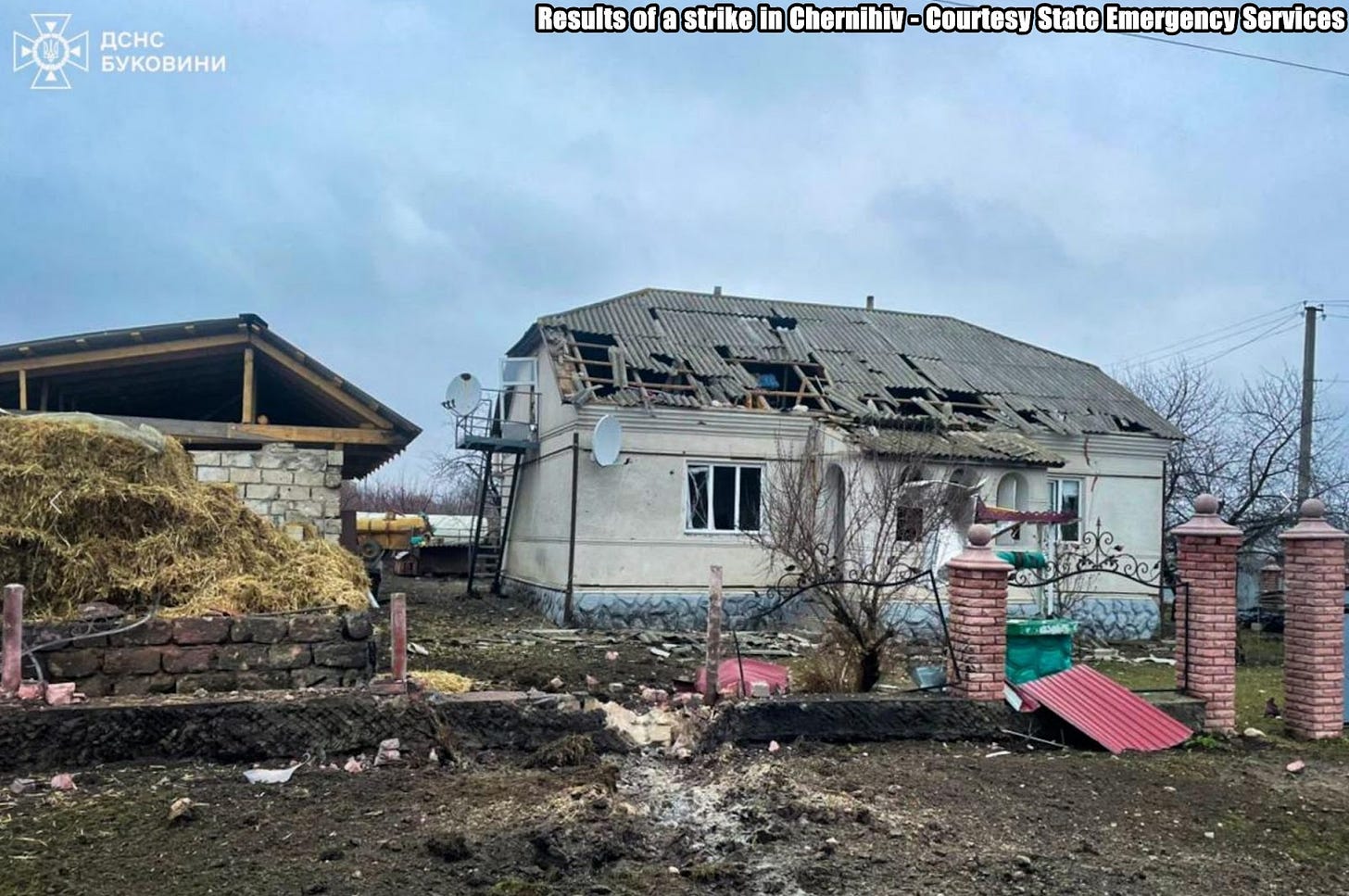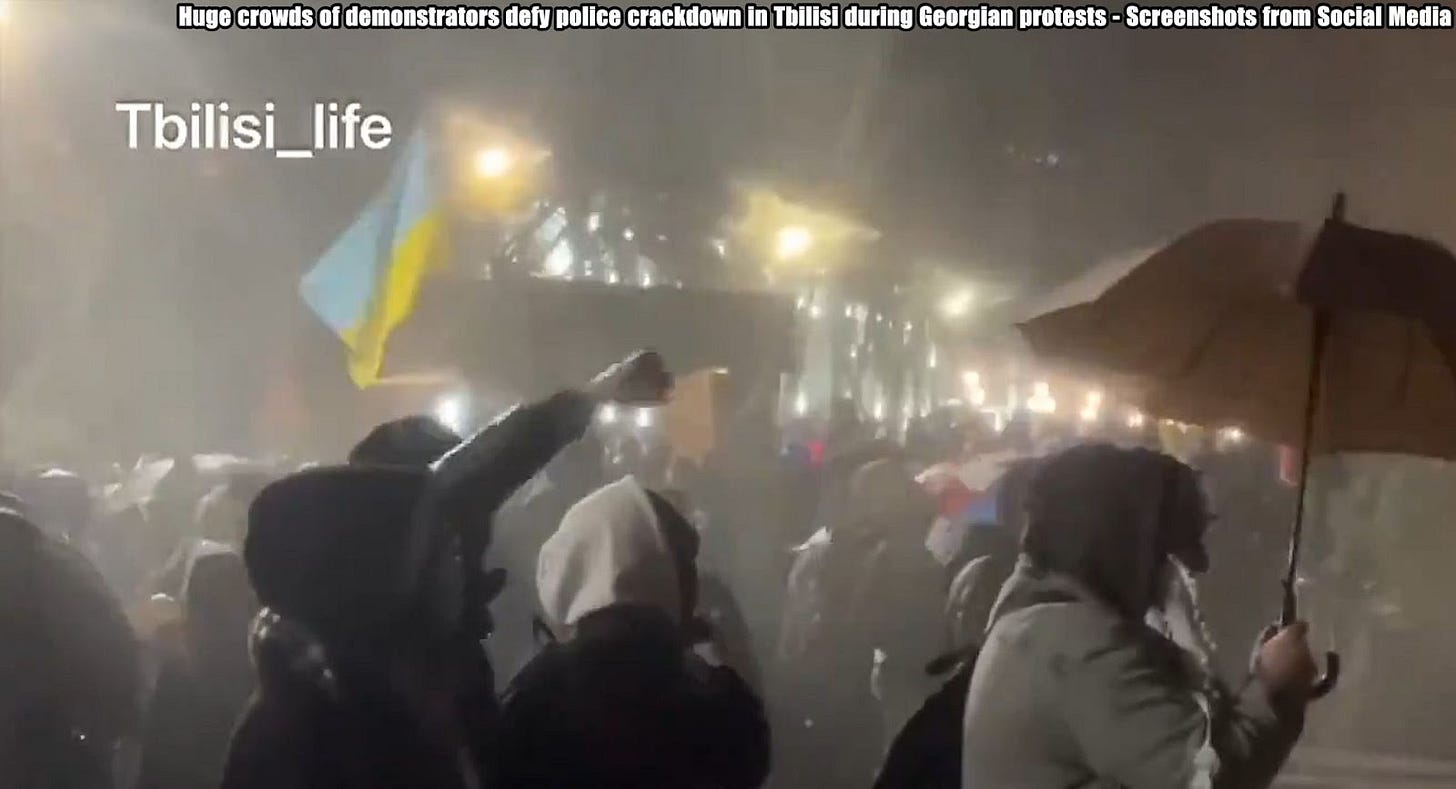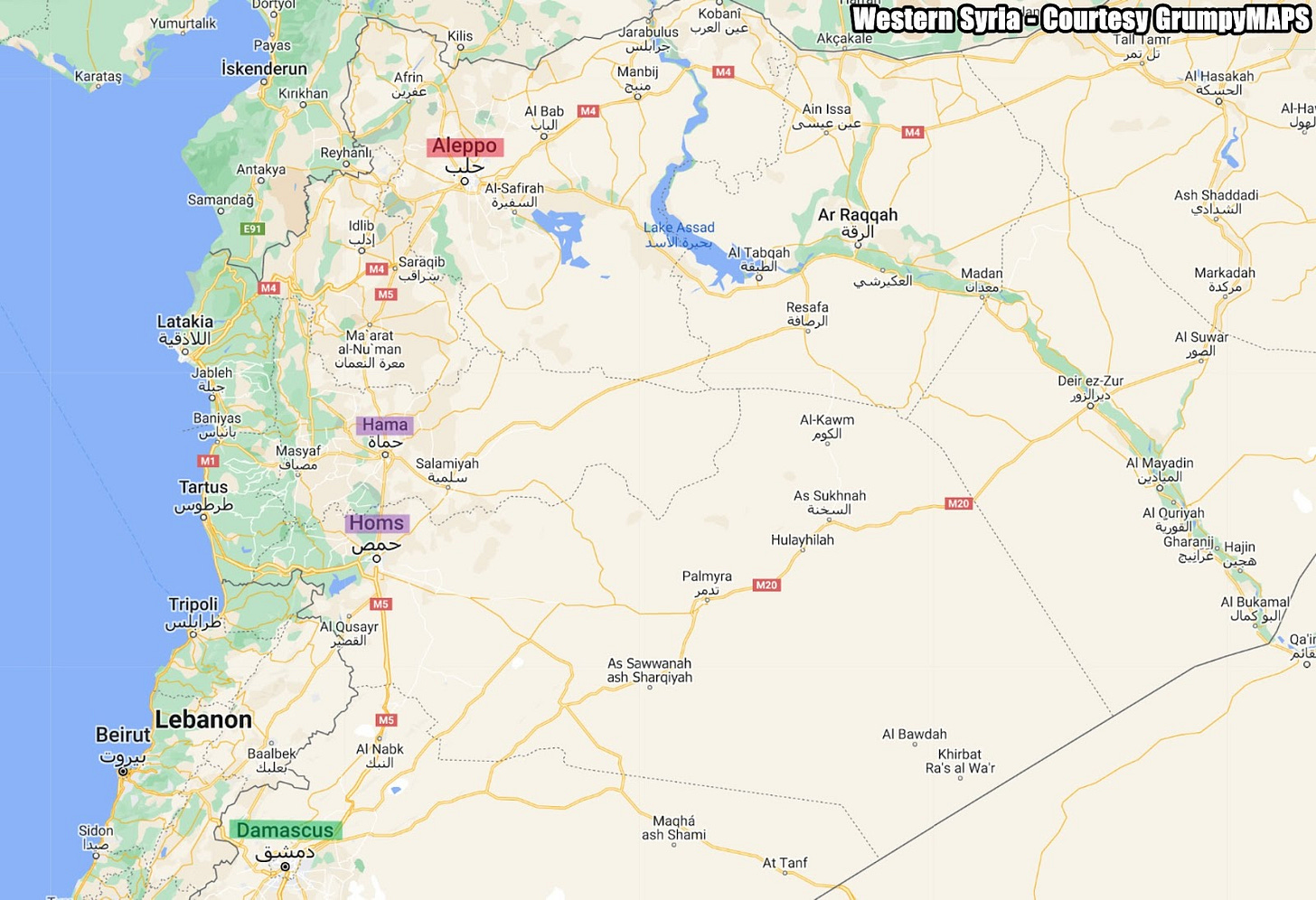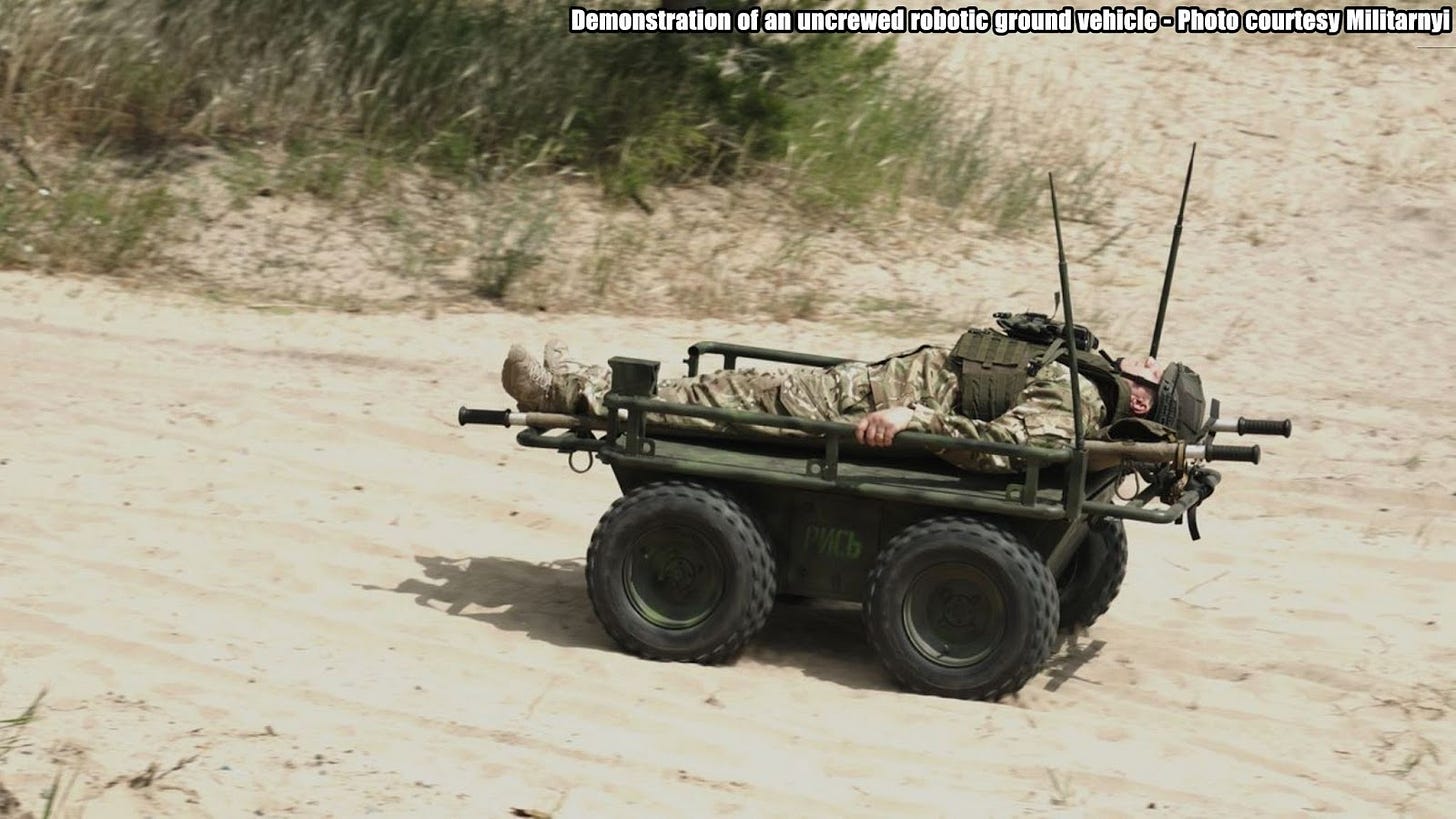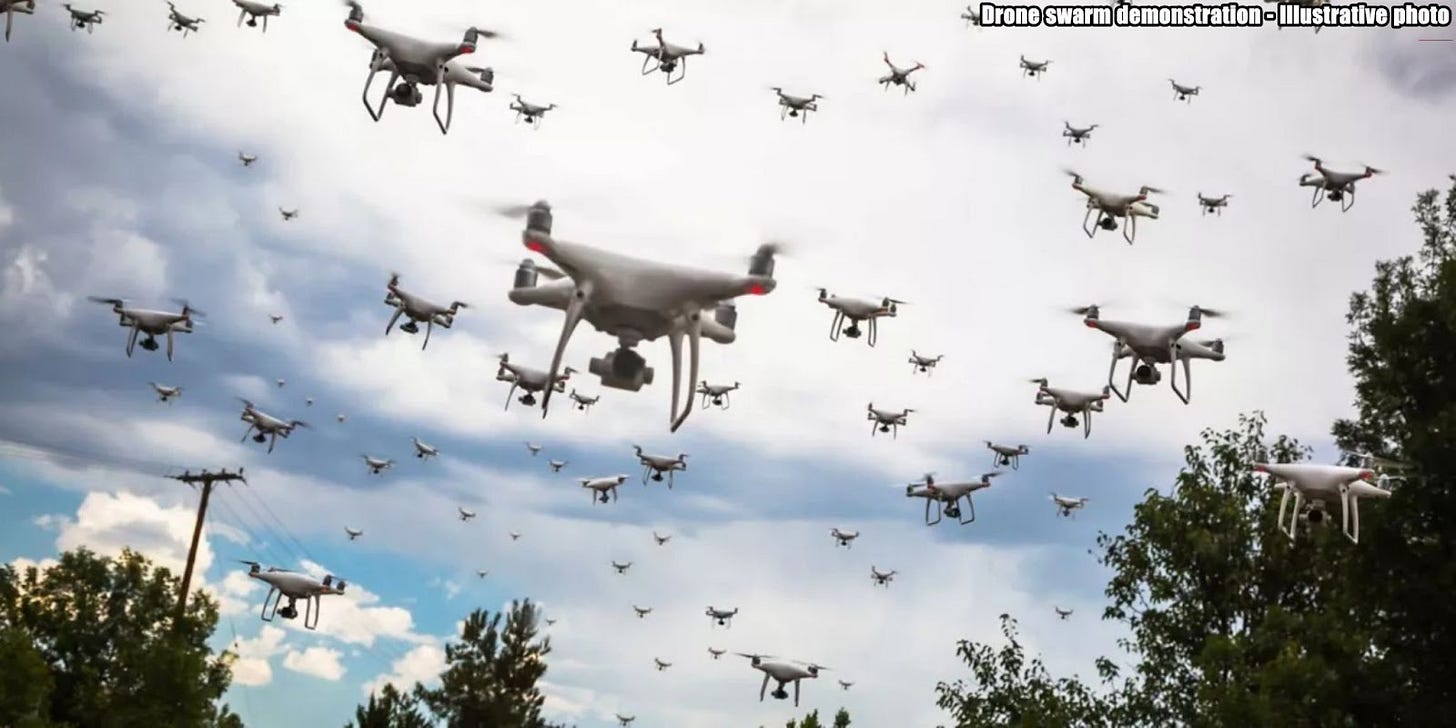Slava Ukraini! In early 2022 I began a Telegram channel aggregating news from a number of sources daily on the war in Ukraine. In June 2023 I began providing a daily draft for the Ukraine War Brief Podcast collecting news from over 70 sources daily, which formed the basis of the script. While the Podcast no longer exists I have continued to make this Brief available for my followers here on Substack for those who wish to keep up with the news from the war. A version of this Brief will also be made available on The People’s Media Substack for those who should choose to subscribe there.
All the latest news on the Russo-Ukraine War 6 days per week
ALONG THE CONTACT LINE
GSAFU Morning Report
The General Staff of the Armed Forces of Ukraine in its Operational Information update at 22:00 on Dec 1 stated that day 1013 of the full-scale invasion of the Russian Federation against Ukraine was about to begin.
During the past two days, 211+158 combat engagements took place. Over the past 48 hours, the enemy carried out 2 missile strikes, 18 air strikes, 503+698 drone strikes and more than 3,000+3000 artillery strikes across the positions of Ukrainian forces.
At the same time, Ukrainian soldiers continue to inflict losses in manpower and equipment on the occupying troops, exhausting the enemy along the entire front line and continue to disrupt the plans of Russian occupiers to advance deeper into the territory of Ukraine.
-
Russia suffered almost 46,000 casualties, lost over $3 billion in military equipment in November.
The Russian army suffered record losses in military equipment and personnel in November in the war against Ukraine, The Kyiv Independent reported citing Ukraine's Defense Ministry on Dec. 1.
Russian losses at the front increased significantly in the fall, while Russia continued to advance in the Donetsk sector, aiming to capture the towns of Pokrovsk and Kurakhove.
In November, 45,720 Russian soldiers were wounded, killed, or captured and thus unable to continue participating in combat operations. This number is equivalent to more than three motorized rifle divisions of the Russian army, according to the ministry.
November also saw the record broken for the enemy personnel losses in one day with 2,030, the highest figure since Feb. 24, 2022.
In November, Ukrainian forces also destroyed 307 Russian tanks, 899 armored combat vehicles, and 884 pieces of artillery.
According to the ministry's calculations, Russia's lost weapons and equipment in November is estimated to be worth over $3 billion, which is more than in September and October.
As of the morning of Dec. 1, the Russian army had lost about 742,130 soldiers, according to the General Staff of the Ukrainian Armed Forces. Over the past day, Russian losses amounted to 1,730 people.
Air Force Daily Report
On the night of Dec 1, 2024 (from 20.00 on November 30) from the directions of Kursk, Orel, Bryansk - Russian Federation. The enemy attacked with 78 attack UAVs of the "Shahed" type and unmanned aerial vehicles of an unknown type.
The air attack was repulsed by anti-aircraft missile forces, electronic warfare units and mobile fire groups of the Air Force and the Defense Forces of Ukraine. Anti-aircraft defense worked in Kyiv, Cherkasy, Chernihiv, Zhytomyr, Sumy and Poltava regions.
As of 09:00, 32 enemy UAVs have been shot down, 45 Russian drones have been lost in location, presumably as a result of countermeasures by the Defense Forces' EW means, and one more is in the air!
Information is being clarified and updated.
On the night of Dec 2, 2024 (from 19:00 on December 1) from the directions of Kursk, Orel, Millerovo, Primorsko-Akhtarsk - Russian Federation. the enemy attacked with 110 attack UAVs of the "Shahed" type and drones of other types.
The air attack was repulsed by anti-aircraft missile forces, electronic warfare units and mobile fire groups of the Air Force and the Defense Forces of Ukraine.
As of 08:30, 52 enemy UAVs were shot down in Kyiv, Cherkasy, Chernihiv, Vinnytsia, Khmelnytskyi, Zhytomyr, Sumy, Poltava, Kharkiv and Dnipropetrovsk regions. 50 unmanned aerial vehicles were lost in location, presumably as a result of countermeasures by EW means of the Defense Forces, 6 — left the controlled airspace in the direction of Russia and Belarus, one more — in the air. Combat work continues!
Information is being clarified and updated.
The Russian Border Incursion
The Institute for the Study of War (ISW), a US based think tank, in its Dec 1 Russian Offensive Campaign Assessment reported that Ukrainian forces recently advanced in the main Ukrainian salient in Kursk Oblast amid continued fighting on Dec 1.
Geolocated footage published on Nov 30 indicates that Ukrainian forces recently advanced north of Novoivanovka (southeast of Korenevo).
A Russian milblogger claimed that Russian forces conducted offensive operations southeast of Korenevo near Darino, north of Sudzha near Plekhovo, and northeast of Sudzha near Martynovka. Ukrainian forces reportedly counterattacked near Pogrebki (northwest of Sudzha).
A senior Ukrainian non-commissioned officer of a platoon operating in the Kursk direction stated on December 1 that Russian forces use powerful electronic warfare (EW) systems to cover and facilitate Russian assault operations in Kursk Oblast.
Elements of the Russian 155th Naval Infantry Brigade (Pacific Fleet, Eastern Military District [EMD]), the 810th Naval Infantry Brigade (Black Sea Fleet [BSF], Southern Military District [SMD]), and the 56th Airborne (VDV) Regiment (7th VDV Division) are reportedly operating in Kursk Oblast.
The Khortytsia operational-strategic group
(Responsible for the northeastern part of Ukraine. )
Kharkiv Sector: Over the last day Ukrainian Defense Forces repelled105 Russian attacks in the area of Kozacha-Lopan, Starytsia, Vovchansk and Tykhe
Kupyansk Sector: Russian Forces carried out 9 offensive actions against Ukrainian defensive positions near Hlushkivka, Kruhlyakivka, Lozova and Zelenyi Hai . 5 engagements are ongoing.
Lyman Sector: Russian Forces carried out 8 offensive actions against Ukrainian defensive positions near Druzhelyubivka, Hrekivka, Terny, Torske and Hryhorivka.
Siversk Sector: In this sector, over the last day, there has been no significant change in the combat environment. Russia did conduct 3 airstrikes against Siversk.
Kramatorsk Sector: Russian forces carried out 1 offensive action against Ukrainian defences in the vicinity of Chasiv Yar.
Toretsk Sector: Over the last day Russian forces carried out 7 offensive actions with air support near Toretsk and Shcherbynivka. 1 engagement is ongoing.
The Tavria operational-strategic group
(Responsible for the central-eastern and southeastern part of Ukraine.)
Pokrovsk Sector : Over the last day in this sector, Russian Forces carried out 33 offensive actions against Ukrainian defensive positions in the vicinity of Myrolyubivka, Promin, Chunyshyne, Lysivka, Dachenske and Zhovte.
Kurakhove Sector: The highest intensity of combat over the last day was in this district, Russia conducted 48 offensive actions in the vicinity of Novodmytrivka, Zorya, Sontsivka, Berestky, Kurakhove, Dalnje, Hannivka and Yelyzavetivka. 10 engagements are ongoing.
Vremivka Sector: Russian forces made 24 attempts to break through Ukrainian defences in the vicinity of Novodarivka, Novosilka, Velyka Novosilka, Novyi Komar, Kostiantynopolske and Trudove. 1 engagement is ongoing.
Orikhiv Sector: In this sector, over the last day, there has been no significant change in the combat environment.
The Odesa operational-strategic group
(Responsible for Kherson, Qırım, (also known as Crimea) and the Black Sea.)
Prydniprovsk Sector: In this sector, over the last day, there has been no significant change in the combat environment. Russian forces made 4 unsuccessful attempts to dislodge Ukrainian units from their positions.
TEMPORARILY OCCUPIED TERRITORIES
Nothing major to report.
THE HOME FRONT
Russian attacks across Ukraine kill 4, injure 23 over past day
Russian attacks against Ukraine killed at least four people and injured 23 across multiple regions, The Kyiv Independent reported citing regional authorities reported on Dec. 2.
Russian forces launched 110 Shahed-type drones and other unmanned aerial vehicles against Ukraine overnight, the Air Force said.
Fifty-two were shot down, 50 were lost across Ukraine thanks to electronic warfare countermeasures, and six flew to Belarus and Russia, according to the statement.
A Russian drone hit an apartment building in the western city of Ternopil, killing at least one person and injuring four, officials said. Around 100 people were evacuated from the damaged building. The blast also damaged windows of the surrounding buildings, a school, and 20 cars.
In Dnipropetrovsk Oblast, a 60-year-old man was injured during Russian attacks against Nikopol and the Marhanets community, Governor Serhii Lysak reported.
Russian attacks against Donetsk Oblast injured five people, Governor Vadym Filashkin reported. Two injuries were reported in the town of Pokrovsk, two in the village of Shevchenko, and one in the Andriivka village.
In Kherson Oblast, three people were killed and 13 injured in Russian attacks over the past day, Governor Oleksandr Prokudin said. The three fatalities and 11 injuries were reported after Russian forces struck a minibus in the city of Kherson on Dec. 1.
Cherkasy, Chernihiv, Chernivtsi, Khmelnytskyi, Kyiv, Luhansk, Poltava, Zhytomyr, Mykolaiv, Sumy, and Zaporizhzhia oblasts also came under attack but no casualties were reported.
RUSSIAN WORLD
Russia’s Sberbank Expects 22-23% Key Rate Hike
Russia’s largest lender Sberbank expects the Central Bank to raise its key interest rate to as high as 23% later this month in its fight against rising prices, The Moscow Times reported citing a senior executive on Monday.
“There’s a high probability of a rate hike by either one or two percentage points because we see that inflation is still relatively high,” Sberbank’s Deputy Chairman of the Board Kirill Tsarev was quoted by the state-run RIA Novosti news agency as saying.
The Central Bank raised its key rate to a record-high 21% in October, with policymakers signaling a high likelihood of further rate hikes in the future.
Central Bank Governor Elvira Nabiullina later warned of “more drastic changes” in monetary policy as defense-driven inflation soars in the third year of Russia’s invasion of Ukraine.
Policymakers are set to meet again on Dec. 20 to decide on the bank’s next rate adjustment.
The Central Bank’s tight monetary policy has led Russia’s second-largest lender VTB to reduce its loan portfolio and profit expectations, VTB CEO Andrei Kostin told Reuters earlier Monday.
VTB’s 2025 profit forecast will decrease to 400 billion rubles ($3.77 billion) from 550 billion rubles ($5.18 billion) this year as a result, he said.
“We simply won’t be able to issue more loans physically. And, of course, our income will no longer be as high,” Kostin was quoted as saying.
INTERNATIONAL NEWS
U.S. Plant's Chinese Owner Shipped Sanctioned Electronics To Russia's War Machine
A Chinese company that owns a California manufacturing plant has sent hundreds of shipments of restricted dual-use electronics to Russia since the Kremlin's invasion of Ukraine, including to sanctioned companies with ties to the Russian military. Radio Liberty reports.
At least one component manufactured by the company, Yangzhou Yangjie Electronic Technology Company Limited, was found in a Russian weapons guidance system recovered from the battlefield in Ukraine, according to a public database maintained by the Ukrainian military.
Yangjie Technology, located in the city of Yangzhou northwest of Shanghai, has sent more than 200 shipments of specific goods to Russia since the start of its full-scale invasion in February 2022, according to customs records obtained by C4ADS, a Washington-based, nonprofit data-analysis and global-research organization.
The listed contents of those shipments -- totaling at least 238 -- included electronic components categorized as "high-priority" by the United States due to their potential use in Russian weapons systems, according to the data obtained by C4ADS and shared with RFE/RL, which independently corroborated more than 150 such shipments.
At least 17 such shipments were sent to a Russian electronics firm hit by U.S. sanctions, customs records show.
The findings further highlight the difficulty Western countries have had in trying to choke off the Russian military's access to Western technology for use in its weapons and operations as its war on Ukraine continues.
China's relationship with Moscow has deepened over the course of the war, both strategically and economically, while Beijing has also aimed to limit blowback from the West, in particular the United States, its largest trading partner.
Washington and the European Union have sanctioned some Chinese companies for providing dual-use technologies that aid Russian forces on the battlefield. After months of pressure, China in October released new export-control regulations aimed at constraining shipments of dual-use goods to Russia.
Still, Western officials have said the flow of goods from China has played a significant role in boosting Russia on the battlefield in Ukraine.
The items shipped by Yangjie Technology, according to the customs records, include certain types of diodes, as well as specific transistors, an electronic device that amplifies or switches electrical currents.
Yangjie Technology also sent at least 173 shipments of "high-priority" dual-use technology to the Russian company Simmetron Electronic Components. Simmetron was hit with U.S. sanctions in May 2023 as part of a broad series of measures aimed to "degrade the Russian Federation's capacity to wage war against Ukraine."
In 2015, Yangjie closed on a deal to buy a U.S.-based semiconductor company called Micro Commercial Components, which says it makes "high-quality discrete semiconductors," some of which can be used in military technology. Headquartered in Simi Valley, California, Micro operates several research facilities in Japan, China, and Taiwan.
A Russian company called VM Components, working under the name Platan and describing itself as a leading provider of electronics components in Russia, received more than three dozen shipments from Yangjie as well, according to customs records.
VM Components is part of a network of companies that work closely with another sanctioned company, JSC Roselektronika, and a Russian entity owned by the Federal Security Service, Russia's main domestic security agency, records reviewed by RFE/RL and C4ADS reveal. The entity is known more widely as the FSB Criminalistics Institute, or by its military code, 34435.
A December 2020 joint investigation by Bellingcat, The Insider, CNN, and Der Spiegel found Russian security service officers linked to the poisoning of opposition leader Aleksei Navalny in August of that year worked under that military unit.
Protests over contested election continue in Georgia.
The Institute for the Study of War (ISW), a US based think tank, in its Dec 1 Russian Offensive Campaign Assessment reported that The Georgian opposition continues to contest the legitimacy of Georgia's ruling Georgian Dream party's electoral victory following Georgian Dream's suspension of Georgia's European Union (EU) membership accession talks.
Georgian Dream announced on Nov 28 that it will suspend the country's EU accession negotiations and will reject EU grants following a European Parliament resolution deeming the largely contested the Oct 26 Georgian parliamentary elections as "neither free nor fair." The Georgian constitution has an enshrined aspiration to join the EU, and Georgian Dream's suspension of EU membership talks contradicts the constitution and the demonstrated will of most Georgians who have strived for EU accession for decades.
The Georgian opposition - comprised of opposition parties, Georgian President Salome Zourabichvili, and Georgian civil society - immediately called for protests and continued to contest the legitimacy of the Georgian Dream party's electoral victory and its actions. Zourabichvili stated on November 30 that she would remain the sole legal authority of the Georgian government until new elections are held and that the new Georgian Dream-dominated parliament has no right to elect a new president in December 2024, as they intend to do.
Georgian presidential elections are currently scheduled for December 14. The Georgian opposition has been protesting Georgian Dream's decision to suspend efforts for EU membership halt across Georgia since Nov 28, and Georgian riot police have violently suppressed peaceful protestors using, water cannons, beatings, and other violent tactics. Various Georgian ambassadors have resigned in protest of Georgian Dream's actions, including Georgian Ambassador to the US David Zalkaliani. The US State Department announced on Nov 30 that it is suspending the US-Georgia Strategic Partnership in response to Georgian Dream's "various anti-democratic actions", while European officials have criticized Georgian Dream's actions, voiced solidarity with the protesters, and suggested sanctioning Georgian authorities. ISW previously assessed that a Georgian Dream parliamentary victory would likely derail Georgia's EU and NATO accession aspirations and degrade Georgia’s relationships with its Western partners.
Russian troops and diplomats hurriedly flee Damascus
Russian troops and diplomats have begun to flee the Syrian capital, Damascus, as the first armed clashes there broke out. The Defence Intelligence of Ukraine (HUR) has reported on Telegram.
"The first armed unrest has broken out in Damascus, prompting Russian troops and diplomats to urgently leave the Syrian capital."
According to Ukrainian intelligence, forces opposing the Russian-backed Assad administration are moving south, with the first urban clashes taking place in Hama, Homs and Suwayda.
The Russian contingent is known to have abandoned Hama and relocated to the Khmeimim airbase. Colonel General Alexander Zhuravlyov, chief of the Russian coordinating headquarters in Khmeimim, has declared that the situation is out of the Assad regime's control.
The Russians have also fled a military base in the city of Khan Shaykhun, leaving behind a huge inventory of weapons and equipment.
HUR also says Russian planes launched airstrikes in Khan Shaykhun on 1 December 2024. The attack was most likely intended to destroy Russian military assets that had been handed over to rebel troops.
Amid the frantic flight of Russian forces, news of the dismissal of the Russian contingent's commander, Lieutenant General Sergei Kisel, began spreading on Arabic-language channels.
In addition, Colonel Vadim Baikulov, who led a unit of Russian special forces, has been summoned to Moscow. He has to explain to the Kremlin why his subordinates were killed and military equipment captured in Aleppo.
Germany's Scholz promises $685 million military aid in Kyiv amid domestic turmoil.
German Chancellor Olaf Scholz unveiled 650 million euros ($685 million) of new military aid as he came to Kyiv on Monday, vowing Berlin would remain Ukraine's biggest backer in Europe at a crucial moment in the war, with Donald Trump set to return to the White House. Reuters reported on Dec 2.
The visit, his first to Kyiv since the early months of Russia's invasion in 2022, comes weeks after his governing coalition collapsed, setting him up for a tough election battle in February.
The political turmoil in Europe's biggest economy adds to a growing feeling of uncertainty in Ukraine, with Russian troops advancing ever faster. It is unclear how much Kyiv's European allies can step up support for Ukraine if Trump cuts back help from its biggest backer.
Scholz and President Volodymyr Zelenskyy met at an undisclosed location and reviewed military drones manufactured by Ukrainian and German firms. They also visited a hospital and spoke to people wounded in the war.
Scholz was expected to hold talks later with Zelenskyy, whose government is urging NATO to invite Ukraine to join the military alliance at a meeting in Brussels this week.
While trumpeting Germany as Ukraine's second-biggest weapons supplier after the United States, Scholz has repeatedly refused to send Taurus cruise missiles to Ukraine, fearing this could draw his country into a direct conflict with Russia.
He also drew fire from allies, including Zelenskyy himself, for holding a phone call with Russian President Vladimir Putin in November, for the first time in almost two years, which critics saw as a bid for domestic political gain.
"Germany will remain Ukraine's strongest supporter in Europe," Scholz wrote on X, adding that he would promise Zelenskyy "further military equipment worth 650 million euros", to be delivered this month.
The package includes IRIS-T air defence systems, Leopard 1 tanks and armed drones, a defence ministry spokesperson said.
On Sunday, new European Council president Antonio Costa and new EU foreign policy chief Kaja Kallas visited Kyiv on their first day in office to demonstrate the EU's support.
Backing for Ukraine is shaping up as a major issue in Germany's election.
Friedrich Merz, the conservative opposition leader who is on course to unseat Scholz, has said Germany should send Taurus missiles and at the weekend said Scholz was raising unnecessary fears.
Roderich Kiesewetter from the conservative Christian Democrats (CDU) accused Scholz of "campaigning on the backs of the Ukrainian population and at the same time ... feeding the Russian fear narrative".
"He is increasingly isolating Germany and endangering our security," he told Monday's Augsburger Allgemeine newspaper.
MILITARY & TECH
Ukraine plans to increase use of AI-powered UAVs
Ukraine will need tens of thousands of uncrewed robotic ground vehicles next year to shuttle ammunition and supplies to infantry in the trenches and evacuate wounded soldiers, Reuters reports citing a senior government minister.
The buggy-like vehicles, an example of how technology is transforming trench warfare in Ukraine, would spare troops from operating in areas near the front where Russian shelling and drones are rife, Deputy Prime Minister Mykhailo Fedorov said.
"This year we purchased several thousand ground platforms, and next year, I believe, we need tens of thousands," the minister, who has overseen drone procurement for most of the war, said in an interview.
The vehicles, he said, are already being used along the front and in Russia's Kursk region, where Kyiv's troops carved out an enclave in an August incursion. Ukraine has several training centres to teach their use, he added.
The use of military technology has rapidly evolved, even as the war has been locked in a bloody, attritional struggle with no major battlefield changes despite Russia's recently accelerating gains 33 months since the 2022 invasion.
Fedorov, whose official remit is digital affairs, has played a prominent role in supporting the development of military technology through a government-backed platform to nurture private-sector innovation. As of this month he no longer oversees the procurement of drones.
Ukraine has focused heavily on increasing production and improving the specifications of long-range attack drones to conduct deep strikes on Russia, narrowing the gulf in capabilities with its adversary.
ARTIFICIAL INTELLIGENCE
Ukrainian production of long-range drones has increased dozens of times since 2023, with President Volodymyr Zelenskyy targeting output of 30,000 of the deep-strike weapons next year, Fedorov said.
Russia has been launching thousands of long-range drones per month, making heavy use of low-cost "decoy" drones that wear down Ukraine's air defence forces, which see a blip on the radar and are forced to shoot it down.
Fedorov said Ukraine was also using decoy drones and was sometimes launching more attack drones on a given night than Russia, but it was not purely a numbers game.
"[AI is] used to some extent, but the more critical issues are connectivity and launch methods of deep strike (drones)," he said.
"Russia has improved monitoring of (Ukraine's) drone launches, quickly responding and targeting launch sites. These nuances require constant launch method and connectivity changes."
Ukraine has attack drones that can fly up to 1,800 km (1,120 miles), he said.
He also confirmed Ukraine was working on drones to intercept the Shahed-type long-range attack drones that Russia uses for its nightly attacks on Ukrainian cities.
"There is some testing by certain companies producing ... aircraft that, thanks to specialised software and radars, can strike Shaheds, but this is still in the research and development phase. There are certain results," he said.
He said Ukraine had contracted to buy 1.6 million drones this year, of which 1.3 million had been supplied, including low-cost "first person view" (FPV) drones that have cameras allowing remote pilots to fly them towards their targets.
Ukraine has also been using dozens of domestically made artificial intelligence-augmented systems for its drones to reach targets on the battlefield without being piloted, allowing it to remain effective in areas protected by extensive jamming.
Fedorov said 10 companies were consistently competing in state procurements to offer AI products.
"I think next year will significantly increase the percentage of autonomous drones with targeting," he said. "We might see the first real drone swarm uses, though not on a massive scale. The first steps will happen."
Russia fired at least 60 North Korean missiles against Ukraine, military intelligence says.
Russia has fired at least 60 North Korean-supplied ballistic missiles during the full-scale invasion of Ukraine, The Kyiv Independent reported citing a Ukrainian military spokesperson’s interview with Radio Free Europe/Radio Liberty on Dec. 2.
North Korea supplied Russia with ammunition, ballistic missiles, and now soldiers since the beginning of the full-scale invasion. Pyongyang has ratcheted up its support for Russia following Russian President Vladimir Putin’s signing of a mutual defense pact with North Korean leader Kim Jong Un in June.
Earlier reports mentioned more than 5 million artillery shells and 100 short-range ballistic missiles, including short-range ballistic missiles of the KN-23/24 type, supplied to Russia.
"Their accuracy, in principle, is not very high. We understand that the technology with which they were manufactured is outdated," Andrii Cherniak, a military intelligence spokesperson, told Radio Free Europe/Radio Liberty.
On top of ammunition and missiles, since late October, thousands of North Korean troops have been fighting in Russia’s Kursk Oblast to expel Ukrainian forces holding approximately 800 square kilometers (309 square miles) of Russian territory.
According to President Volodymyr Zelenskky, they suffered their first losses. Pyongyang is believed to receive economic support and assistance for its nuclear weapons program in return for troops and arms supplies.
That’s it for today’s Brief folks if you would like to keep up with events in Ukraine daily please consider subscribing.
Feel free to share this update with your friends. Heroyam Slava!







